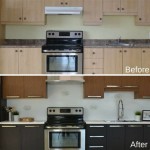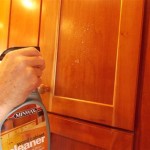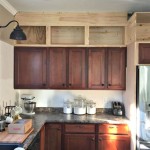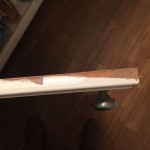Can You Restain Wood Cabinets?
Restoring the luster of wood cabinets is a popular home improvement project that can significantly enhance a kitchen or bathroom's aesthetic appeal. Staining existing cabinets is often a more cost-effective alternative to replacing them entirely. Understanding the process and the factors that influence its success is crucial for achieving desirable results.
Assessing Cabinet Suitability
Not all cabinets are suitable candidates for restaining. Cabinets constructed from solid wood or wood veneer are generally receptive to the process. However, cabinets with a plastic laminate or a factory-applied finish that cannot be removed may not accept stain effectively. Determining the cabinet material is the first step in evaluating the feasibility of restaining.
Preparing the Cabinets
Thorough preparation is essential for successful staining. This involves removing hardware such as handles, knobs, and hinges. The next step involves cleaning the cabinets to remove grease, grime, and any built-up residue. A degreasing cleaner is typically recommended for this purpose. After cleaning, the cabinets should be allowed to dry completely.
Stripping the Existing Finish
Existing finishes, such as varnish or previous stain, must be removed to allow the new stain to penetrate the wood properly. Chemical strippers are commonly used for this task. Applying the stripper according to the manufacturer's instructions and allowing sufficient dwell time is crucial. A scraper or putty knife can then be used to remove the softened finish. Neutralizing the stripper, as per the manufacturer's guidelines, is necessary to prevent interference with the new stain.
Sanding the Wood
Sanding the wood after stripping is essential for creating a smooth, uniform surface for the new stain. Starting with a coarser grit sandpaper (e.g., 120-grit) and progressively moving to finer grits (e.g., 220-grit) will achieve the desired smoothness. Sanding with the wood grain is crucial to prevent scratches. Thoroughly removing sanding dust with a tack cloth or vacuum is the final step in the sanding process.
Selecting the Stain
Choosing the right stain is critical for achieving the desired aesthetic. Oil-based stains offer deep penetration and rich color, while water-based stains are known for their ease of cleanup and lower odor. Gel stains are another option, providing excellent control and coverage, especially on vertical surfaces. Testing the stain on an inconspicuous area of the cabinet is highly recommended to ensure the color and finish meet expectations.
Applying the Stain
Applying the stain evenly and consistently is paramount. A brush, rag, or foam applicator can be used for this purpose. Applying thin coats and allowing each coat to dry completely before applying the next is essential for preventing blotchiness and ensuring even penetration. Following the manufacturer's instructions regarding drying times is crucial.
Protecting the Finish
Once the stain has dried completely, applying a protective topcoat is necessary to seal and protect the finish. Polyurethane is a common choice, available in various sheens, from matte to gloss. Applying the topcoat in thin, even coats and allowing sufficient drying time between coats will ensure a durable and attractive finish.
Ventilation and Safety
Working in a well-ventilated area is crucial when using chemical strippers, stains, and topcoats. Wearing protective gloves, eye protection, and a respirator is recommended to minimize exposure to potentially harmful fumes. Proper disposal of used rags and materials is also essential for safety and environmental responsibility.
Troubleshooting Common Issues
Blotchy finishes can occur due to uneven application or insufficient drying time between coats. Light sanding between coats can help address this issue. Drips or runs can be remedied by lightly sanding and reapplying the finish. If the stain color is not as desired, stripping and restaining may be necessary.
Professional Assistance
While restaining cabinets can be a DIY project, complex situations or a lack of experience may necessitate professional assistance. Professional refinishers possess the expertise and equipment to handle intricate projects and achieve optimal results.

How I Updated My Oak Cabinets Without Paint By Using Briwax Easy Budget Kitchen Makeover Only 24

Staining Your Wood Cabinets Darker Young House Love

Can You Restain Cabinets A Comprehensive Guide Southwest Kitchen

Cabinet Refinishing Guide

How To Make Rustic Kitchen Cabinets By Refinishing Them The Best Stain Color Amanda Katherine

Refinishing Kitchen Cabinets Modern Refacing Made Easy Wisewood

Repainting Vs Restaining Kitchen Cabinets Kitchens Redefined

Cabinet Refinishing An 8 Step Guide For Pro Painters Ppc

The Fast Affordable Way To Upgrade Your Kitchen Cabinet Refinishing

Staining Cabinets Upgrades Advice Needed
Related Posts








